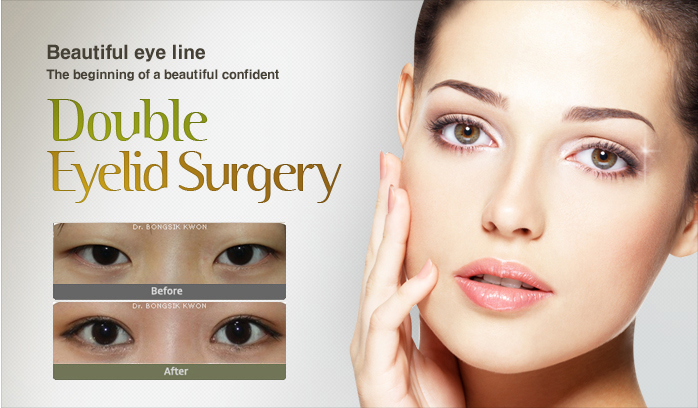
01Understanding Asian double eyelid
History and Dilemma
When the epicanthal fold is severe, the surgical incision of skin flap also become longer, and a scar could be easily visible in conventional method, which based on the concept of local skin flap. Although it has been reasoned that combined epicanthoplasty is helpful in Asian double eyelidplasty, there has not been clear understanding about epicanthal fold, resulting in controversies for solution. There have been so many epicanthoplasty methods developed in its early days, which are mostly based on skin flap concept. Currently using methods are combined technics including skin excision, z-plasty, myotomy or myectomy of preseptal orbicularis muscle, skin redraping, plication of medial canthal ligament and so on.
The development of incomplete methods were unavoidable without understanding about true nature of the epicanthus. As the clinical significance of the epicanthus is mainly related with Asian double eyelidplasty, essential epicanthoplasty should be a key to plastic surgeons for choice of all the type of double eyelid including high outfold type(parallel type). But, there has not yet been a potent epicanthoplasty method which deserves universal solution for Asian double eyelidplasty before development of devolutional epicanthoplasty (Kwon’s method, so called magic epicanthoplasty). Dr. Kwon researched basically the formative causes of the differences of Asian eyelid, and also epicanthal deformity and absence of double eyelid. Dr. Kwon finally solved this conundrum, and suggested Kwon’s Theory about the evolution of eyelid to explain anatomical differences of Asian eyelid and Kwon’s Method for Asian blepharoplasty based on devolutional concept.
Differences of appearance in Asian eyelid
Asian eyelid with incomplete double eyelid or without double eyelid

The canthus of Caucasian is exposed completely, whereas the inner part of medial canthus of Asian eye is veiled by the epicanthus. The shapes of the canthal angle are quite various, but generally Asian canthal angles are rounder and shorter than those of the Caucasians. There are various distortions of canthal shape in Asian medial canthus which have been affected in the eyelid evolution. The epicanthus and single eyelid exists as a normal characteristic in Asian ethnicity, and it is peculiar to East Asians. Asian blepharoplasty can be best performed with special reference to the anatomical blueprint and implemented with respect to the devolutional concept of normal eyelid structure with supratarsal crease.
Typical Asian single eyelid and Caucasian double eyelid

Anatomical differences of eyelid between Caucasian and Asian
Anatomical charicteristics of Asian upper eyelid :
Thick, streched skin
Subcutaneous fat
Preseptal/pretarsal fat
Thickened, malpositioned orbicularis muscle
Lax, ballooned septum with lower insertion with levator aponeurosis
Prolapsed, hypertrophied preaponeurotic fat pad with incompentant septum
Weak, incomplete anterior expansions of the levator aponeurosis.
Stretched, weakened levator aponeurosis and Muller muscle
Smaller vertical height of tarsal plate
Although the eyelid is very thin, various tissues (skin, orbicularis muscle,septum,levator muscle, Muller muscle, tarsal plate, fat, conjunctiva) are composed in it. The levator muscle and mullermuscle are those that help open the eyes. In Caucasian, the levator aponeurosis is usually attached to the tarsus and skin of inferior part of eyelid . The strands of the muscle tissues (levator expansion) are attached to the back of the skin of the eyelid, and the skin attached is pulled during eye opening, then a double eyelid is formed.
The fusional part of the orbital septum and levator aponeurosis in Caucasian eyelid is typically in the skin crease (8-12 mm from eyelid margin). Its location lies above the superior tarsal border(2-5mm), which limit the downward prolapse of the orbital fat pads and enable aponeurotic expansions to insert toward the subdermal surface of the pretarsal eyelid skin. Whereas the fusional part lies at the lower point in Asian eyelid and the height of tarsal plate is relatively less than Caucasian’s(more than 8mm in Caucasian). Because of the differences in the eyelid anatomy of Asians, the surgical methods ususally applied to Caucasian cases cannot yield the favorable result in Asian blepharoplasty. Considering the differences of the Asian eyelid and relationship of the epicanthus and double eyelid, structural Asian blepharoplasty based on devolutional concept should be applied to establish a appropriate plan and accomplish best results. The devolutional Asian blepharoplasty can yield much better, natural looking surgical results because it is basically different from conventional blepharoplasty based on Caucasian’s eyelid anatomy
For Asian blepharoplasty, the upper eyelid should be evaluated for :
Epicanthus and epiblepharon with/without orbicularis muscle
malposition
Existence or absence of crease
Excess and thickness of skin
Amount of preaponeurotic fat,usually pseudoherniated and hypertrophied
Blepharoptosis
Pericanthal skin tension
Shape of medial canthus
Brow ptosis and lacrimal gland ptosis
Inclination between medial canthus and lateral canthus
Eyelash direction and prickling around medial canthus
Skin fold on lower eyelid and related wrinkles
Sayoc’s Theory for supratarsal crease (double eyelid)
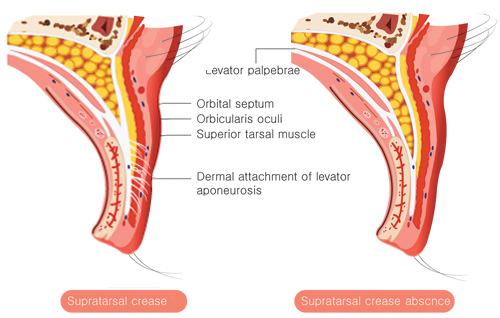
However, the electron microscopic studies confirmed that levator aponeurotic fibers penetrate the orbicularis muscle in both single and double eyelids of Asian, of course Caucasian. This finding suggested that Sayoc’s theory of the “levator expansion” had been incorrect.
Kwon’s Theory for Asian eyelid
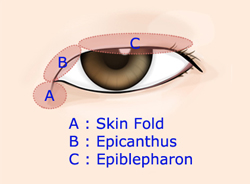
Three parts of the eyelid which are affected in evolutional process. In eyes with a double eyelid, parts of levator muscle are attached to the back of the skin. On the other hand, an eye without a double eyelid has a structure called a epiblepharon which result from orbicularis oculi muscle displacement . Also, the preaponeurotic fat tissue is drooped down like pseudoherniation.
If so, why does the supratarsal crease not exist although aponeurotic fibers do penetrate the orbicularis muscle in Asian single eyelid? Dr. Kwon reconsidered basically without stereotype for previous theory about Asian double eyelid and the epicanthus from 2005, because Sayoc’s theory could not explain absence of Asian double eyelid and presence of epicanthus clearly. Dr. Kwon’s research tried to address the formative causes of epicanthal deformity and loss of double eyelid at the same time in evolutional aspect. Dr. Kwon’s research concluded that the answer for Asian double eyelid is not “not previously existed” but “lost” during evolution. Environmental adaptation is the basic cause for loss of supratarsal crease and formation of the epicanthus. Genetically, all modern humans are included into the subspeciesHomo sapiens sapiens,i.e. the subspecies of Homo sapiens. It has been reasoned that the racial differences of modern humans are just phenotypic variations. The stereotype of Sayoc’s theory may mislead plastic surgeons to misunderstand Asian double eyelid and epicanthus incorrectly. So, the evolutionary approach to Asian epicanthus or absence of supratarsal crease has not been researched and not suggested ever. Dr. Kwon suggested Kwon'stheory for the evolution of Asian eyelid.

Loss of medial crease, formation of the epicanthus, loss of mid-lateral crease, formation of the epiblepharon occur in sequence.
I. Stage of hypertrophy: The hypertrophy of orbicularis oculi muscle and depressor supercilli muscle develop by repeated frowning. The hypertrophy of orbicularis oculi muscle cause attenuation of the aponeurotic expansion which penetrate through orbicularis muscle. The aponeurotic penetrations
loosen and become sparse.
II. Stage of sheer stress: Complete detachment of aponeurotic expansions with loss of supratarsal crease takes place on point S by sheer stress. The detachment of aponeurotic fibers can occur beneath the orbicularis muscle or on the orbicularis muscle. Orbicularis oculi muscle contraction acts as sheer tensional stress with depressor supercilli muscle. The depressor supercilli muscle plays an ancillary role.
III. Stage of tensional stress: The successive loss of medial crease below point S results from displacement of preseptal orbicularis oculi muscle toward eyelash and the vicious cycle between malpositioned muscle hypertrophy and crease loss. The orbicularis oculi muscle contraction mainly act as tensional stress on remaining aponeurotic fibers and medial crease.
IV. Stage of compressional stress: Excessive contraction of orbicularis oculi muscle acts as compressional stress on overlying skin of upper medial eyelid with resultant vertical skin shortage and tension. The tight tension band develops due to vertical skin shortening of upper medial eyelid.
V. Stage of traction and tensional stress: Contraction of orbicularis oculi muscle acts as tensional stress on remaining supratarsal crease resulting in successive loss of supratarsal crease on the upper eyelid superiorly and/or act as traction force causing skin tent toward point P on the lower eyelid inferiorly. During and after formation of a tight tension band by vertical skin shortage, the orbicularis oculi muscle contraction causes a prominent skin fold on the lower eyelid by pulling-up the muscle point of origin like setting up a tent pole during contraction. The preseptal orbicularis muscle pulled up its origin superolaterally with skin tent on lower eyelid during contraction.
VI. Stage of degeneration: The atrophy of orbicularis oculi muscle and accompanying degenerative fibrosis develop, leaving the epicanthus with incomplete crease or epicanthus without crease.
The hypertrophied orbicularis oculi muscle becomes atrophied and replaced by fibrosis, but there remains vertical skin shortage and tension left on upper eyelid and skin fold and wrinkles on lower eyelid. Also there has been left centripetal fibrosis toward point p under the skin of lower eyelid.

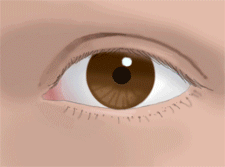
Increased blood supply induced by hypertrophied orbicularis muscle and climate factors would cause hypertrophy and pseudoherniation of preaponeurotic fat. Displacement of orbicularis muscle and fat pad would affect the levator muscle and Muller’s muscle. A relatively longer medial canthal ligament and underdeveloped nasal bone would be additional evolutional manifestations by hypertrophy of the orbicularis oculi and excessive tension.
(new paradigm in Asian double eyelid surgery)
Structural eyelidplasty in Asian eyelid based on devolutional concept : Combined Epicanthoplasty and Double Eyelidplasty as One Surgery
Examples)Magic epicanthoplasty combined with a non- incisional double eyelid surgery

Examples)Magic epicanthoplasty combined with a non- incisional double eyelid surgery

Examples)Magic epicanthoplasty combined with a revisional double eyelid surgery

There are three general methods, the complete incision method (incision), partly cutting (partial incision), and cutting for only the needle to enter(buried suture, non-incisional method). From any among them, we must connect a part of the levator muscle to the eyelid skin. There are merits and demerits respectively and it should be determined by enough consultation considering the length and size of the eyes, thickness of the skin, power to open eyes, quantity of fat, epicanthal folds and so on. There are many differences in devolutional eyelidplasty from conventional eyelidplasty without devolutional concept. The structural Asian eyelid surgery based on devolutional concept(magic epicanthoplasty combined with double eyelid surgery) dramatically improves the epicanthus and stably connects the eyelid skin with the levator muscle. In devolutiona lAsian eyelidplasty, destructive procedures on surgical crease for stronger adhesion is less necessary. The tensional stress on crease by vertical skin tension is main cause of crease loss after double eyelidplasty in Asians. Contraction of malpositioned orbicularis oculi muscle in vertical direction is also a potential cause of tensional stress on surgical crease. Because we have resolved the possible causes of crease loss with devolutional epicanthoplasty, aggressive adhesion which performed in conventional double eyelidplasty is less necessary.
In more cases, we can apply non-incisional(or partial incisional) method for crease formation in devolutional eyelidplasty except excessively thick skin condition with true epiblepharon. There are more incidence of mild blepharoptosis in Asian eyelids. We think mild blepharoptosis in Asian eyelid is related with the eyelid evolution. After the evolutional process, the loading conditions of levator muscle had been worsened. The fibrous tissues within the epicanthus and the epiblepharon, vertical skin tension on upper eyelid, hypertrophied orbicularis oculi muscle and hypertrophied preaponeurotic fat pad add levator and muller muscle more loadings, and act as causal factors of blepharoptosis. When we evaluate blepharoptosis, we should consider the epicanthus related factors. When we perform blepharoptosis surgery with devolutional epicanthoplasty simultaneously, correction of blepharoptosis become complete and is expected to get better result. Through more than five thousands cases of people who already underwent devoutional eyelidplasty by Dr. Kwon, Kwon’s theory and method has been proved to be a very effective and universal technique for Asian eyelid. The surgical outcomes are very natural and satixfactory.
Examples)Structural Asian Blepharoplasty , combined magic epicanthoplasty and double eyelid surgery
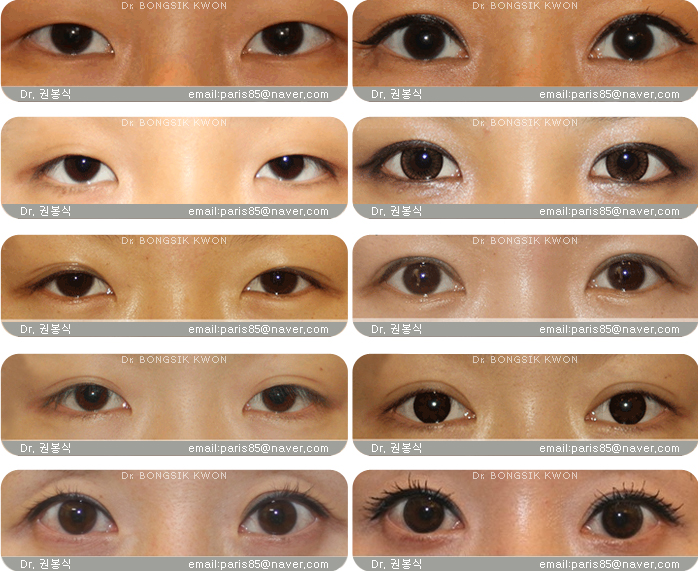
02Considerations in Asian double eyelid surgery

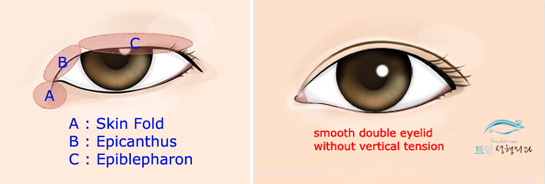
Epicanthus, Epiblepharon,Attachments between Levator muscle and skin
The preexisting vertical skin tension on medial eyelid acts as tensional stress on newly formed surgical crease. The epicanthal skin tension is considered as a major factor which inhibits the sustainability of surgical crease in Asian double eyelidplasty. Also, the malpositioned orbicularis muscle can be reactivated as a vertically acting inhibitor which causes active tensional stress on mid-lateral surgical crease, especially when we have performed the outfold type double eyelidplasty without epicanthoplasty. Therefore, Asian double eyelid surgery should reform not only this attachment, but also should resloves the epicanthus and epiblepharon. Then, we can finally creates anatomically stable crease and natural-looking beautiful eyes.
Favorable structural factors for a beautiful Asian eye with a clear double eyelid :
Blepharofissure(The width of the eyes) is long and the tails of the eyes are not so pointed upwards.
The distance between the eye and eyebrow is not short.
The skin of the eyelid is not droopy.
The eyelid skin is thin
Proper amount of fat exists but not too much.
There is no severe epicanthus and epiblepharon.
The function of the muscle to open the eyes is normal and the exposure of pupil/iris is enough for bright looking eye.
Both eyes are symmetric
The position of the eyebrow is not hung down and is symmetric.
In cases that a lot of these conditions are satisfied, the Asian blepharoplasty can express very good results without much difficulty. But actually, most of cases are not like that. If patient don’t meet any or only a few of these conditions, there may be a high chance that less satisfactory results may be shown.The unfavorable conditions are much related with epicanthus and eyelid evolution. In unfavorable cases, devolutional concept of Asian blepharoplasty is more important. We can get better result through structural eyelidplasty based on devolutional concept. Through cases who already underwent devolutional Asian blepharoplasty, this method has been proved to be a very satisfactory and beneficial method for Asian eyelid. We could lessen the rate of sausage phenomenon, loss of surgical crease and hypertrophic scar obviously in unfavorable cases. The surgical outcomes are very natural and much better than conventional double eyelidplasty.
Functional aspect of a double eyelid : field of vision
The eye of Asian without supratarsal crease is veiled by various amount of skin drooping and the eyeline where the lashes grow is hidden beneath the soft tissues called epiblepharon. The more the eyelid tissues droops down, the smaller and the puffier the eyes look. A single eyelid of Asians is likely to cover the iris and pupil partially. When skin drooping is severe, eyelashes can prickle the cornea and it can cause problem of visual acuity . In this case, a double eyelid surgery removing parts of the drooping eyelid , forming a double eyelid and extending exposure of pupil, will brighten the patients’ vision. Therefore, a double eyelid surgery has a positive effect to get a better vision for the basic function of the eyes. After double eyelid surgery, the eyes look more clear and bright.
Examples) An excisional double eyelid surgery has an beneficial effect on providing a better vision (exposure of pupil)

Examples) Forming a clear double eyelid and more exposure of pupil/iris by ptosis correction and revisional double eyelid surgery

Examples) Forming an inner type of double eyelid and increased exposure of pupil by ptosis correction and a double eyelid surgery.

Examples) Forming an parallel type of double eyelid and increased exposure of pupil/iris by ptosis correction and double eyelid surgery

03The relationship between epicanthus and double eyelid in Asian eyelid
The epicanthus is the most significant factor for determining the shape of the double eyelid, but it was not well-known. Previously plastic surgeons also thought that epicanthoplasty is just ancillary procedure, it might be natural because plastic surgeons didn't know what the epicanthus exactly is. Additionally, unsightful scar formation and unsatisfied result may appear after defective previous epicanthoplasty methods. Considering previous history of Asian blepharoplasty, epicanthal folds have been an important key, but it had not been corrected properly because of defective methods based on defective understanding about the epicanthus. When women have a consultation about the double eyelid surgery, most of them ask for clearer and wider eyes such as the look of an actress.
Most women say "I want to have beautiful and clear eyes", or "I want to have bigger eyes and bigger crease after surgery" during consultations. However, a double eyelid surgery without epicanthoplasty will likely make the eyes look unsatisfactory because this will result in a wide interepicanthal distance and incomplete double eyelid. If a person who has severe epicanthus, small eyes and a wide interepicanthal distance, take only double eyelid surgery itself, the surgery can result in a unfavorable appearance by the epicanthus covering over the epicanthal region. In case of less severe epicanthus, the double eyelid surgery alone can possibly make relatively desirable and favorable lines, but only an infold type of small double eyelid will appear after all. Performing double eyelid surgery on Asian eyes without properly managing the epicanthus causes inevitably incomplete results(small infold or large awkward crease) or can be a critical reason for getting double eyelids to fade away. In fact, most of the problems after Asian double eyelid surgery are caused by the tension of the remaining epicanthus.
Good candidates of Asian eyelid surgery are determined mostly by the degree of the epicanthus. Dr. Kwon reasoned that the epicanthus is a manifestation of the eyelid evolution by hypertrophy of the orbicularis oculi muscle. The affected areas of eyelid can be divided into three parts in aspect of their evolutional processes. The manifestations of the eyelid evolution consists of 1) The epicanthus with vertical skin shortage and tension on upper medial eyelid, 2) The epiblepharon with loss of crease on the rest upper eyelid. 3) Skin fold on lower eyelid. The epicanthus exists as a remnant fibromuscular volume on the upper medial canthal region with vertical(actually diagonal, relative meaning in relation to horizontal supratarsal crease) skin shortage and tension which causes difficulty in horizontal skin folding. It acts as a major hindrance of a double eyelid formation in Asian blepharoplasty. The fibrous tissues and malpositioned orbicularis muscle prevents the even transmission of levator muscle power toward the medial skin because the aponeurotic fibers have been detached and do not extend to the epicanthal skin area any more. The preexisting vertical skin tension acts as tensional stress on newly formed surgical crease. The epicanthal skin tension is considered as a major factor which inhibits the sustainability of surgical crease in Asian double eyelidplasty.
Also, the malpositioned orbicularis muscle can be reactivated as a vertically acting inhibitor which causes active tensional stress on mid-lateral surgical crease, especially when we have performed the outfold type double eyelidplasty without epicanthoplasty.
Examples)Magic epicanthoplasty combined with a non- incisional double eyelid surgery

Although it seems that only magic epicanthoplasty or only double eyeliplasty makes an some effect on eye, combined surgeries make harmonious surgical plans and dramatic results for beautiful Asian eye considering the correlation between epicanthus and double eyelid. It is unnecessary to hesitate to have an epicanthoplasty because of the development of devolution epicanthoplasty. Recently, taking double eyelid surgery combined with magic epicanthoplasty is becomming a new paradigm of Asian blepharoplasty
04The structural double eyelid surgery in Asian (Kwon’s Method)
The concept of structural eyelidplasty in Asian:
New paradigm in Asian blepharoplasty :
Combined Epicanthoplasty and Double Eyelidplasty as One Surgery under Devolutional Concept
What we should do for Asian blepharoplasty is to understand the evolution of eyelid and reverse evoutional processes for stability of surgical crease with minimally invasive technique.If surgeons understand evolutional relationship between the epicanthus and the supratarsal crease, epicanthoplasty should be considered the core surgery for Asian double eyelidplasty, as there is close relationship between loss of supratarsal crease and development of the epicanthus and epiblepharon. Considering the relationship of the epicanthus and double eyelid, these combined surgeries can acomplish a perfect plan and create best results.
What we do in combined devolution epicanthoplasty and double eyelidplasty in sequence.
1. Design both epicanthoplasty and double eyelid surgery simultaneously
2. Mark the marginal transverse incision along the skin tension line of original canthal margin on lower eyelid
3. Incision for epicanthoplasty and double eyelidplasty
4. Elevation of flap for epicanthoplasty
5. Shaving excessive fibrous tissues under upper epicanthal skin flap, if necessary
6. Reposition of orbicularis oculi muscle
7. Confirming absence of vertical tension and smooth skin folding along the designed crease by simulation of crease folding.
8. Dissection or resection of eyelid soft tissues in double eyelidplasty
9. Removal of orbital fat, if necessary
10. Anchoring suture for crease formation
11. Skin closure
There are many differences in devolutional eyelidplasty from conventional eyelidplasty without devolutional concept. The epicanthus and epiblepharon is same manifestation except their location. Both are composed of preseptal orbicularis muscle and degenerative fibrous tissues which replaced the room of atrophied orbicularis oculi muscles. There are more incidence of mild blepharoptosis in Asian eyelids. We think mild blepharoptosis in Asian eyelid is related with the eyelid evolution. After the evolutional process, the loading conditions of levator muscle had been worsened.
The fibrous tissues within the epicanthus and the epiblepharon, vertical skin tension on upper eyelid, hypertrophied orbicularis oculi muscle and hypertrophied preaponeurotic fat pad add levator and muller muscle more loadings, and act as causal factors of blepharoptosis. We can experience the improvement of mild blepharoptosis after devolutiona lepicanthoplasty often. When we evaluate blepharoptosis, we should consider the epicanthus related factors. When we perform blepharoptosis surgery with devolutional epicanthoplasty simultaneously, correction of blepharoptosis become complete and is expected to get better result. Also in devolutionaleyelidplasty, destructive procedures on surgical crease for stronger adhesion is less necessary.
The tensional stress on crease by vertical skin tension is main cause of crease loss after double eyelidplasty in Asians. Contraction of malpositioned orbicularis oculi muscle in vertical direction is also a potential cause of tensional stress on surgical crease. Because we have resolved the possible causes of crease loss with devolutional epicanthoplasty, aggressive adhesion which performed in conventional method is less necessary. In more cases, we can apply non-incisional method for crease formation except excessively thick skin condition with true epiblepharon. When we should remove excessive and malpositioned soft tissues in cases of droopy eyelids with epiblepharon, conservative resection for resolving the displaced soft tissues of the anterior lamella and partial removal of preaponeurotic fat in the posterior lamella is enough without unnecessary tissue injury. The overactive resection and resultant unnecessary tissue injury only cause prolonged swelling and depression scar.
Unlike conventional methods, Structural Asian eyelidplasty (Kwon’s method) have merits such as :
Less invasive procedure and less tissue injury resulting in less swelling
More natural surgical result
Better result of combined ptosis correction.
Minimal incision scar
Less risk of crease loss
Prevention of swelling retention by lymphatic blockage which is caused by vertical tension
Enabling high parallel crease
Ease in converting infold type crease to outfold
Ease in refining unnatural out-fold crease which was formed by double eyelidplasty only
If we review the eyelid evolution and consider the epicanthus in relation to double eyelid, Asian double eyelidplasty would need to be refined more in combination with epicanthoplasty under devolutional concept. Dr. Kwon emphasize that epicanthoplasty needs to be considered as a core surgery for Asian double eyelidplasty, especially when forming the parallel-type of double eyelid. Epicanthoplasty is not an ancillary surgery in Asian double eyelidplasty,but combined epicanthoplasty and double eyelidplasty based on devolutional concept deserve one complete "structural eyelidplasty" for Asians.
Through more than five thousands cases of people who already underwent devoutional eyelidplasty by Dr. Kwon, Kwon’s theory and methodhas been proved to be a very effective and universal technique for Asian eyelid. The surgical outcomes are really natural and satisfactory.
Examples) Example of an eye with a natural double eyelid and a slight epicanthus. The caruncle(red part) is exposed almost completely and the natural inout fold is expressed. The eyeline is exposed fully up to the canthal angle(corner) and the eyelashes decorate eyes so beautifully.
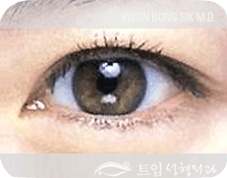
Examples) Magic epicanthoplasty with revisional double eyelid surgery was performed

Examples) Combination of magic epicanthoplasty and incisional double eyelid surgery

Examples) Combination of magic epicanthoplasty and double eyelid surgery


Examples) This is a case of the double eyelid surgery without the improvement of the epicanthus.

The right eye (actually on left from the point of view of the reader) looks unnatural because the outfold is designed above the epicanthal fold. The crease become attauated. It is likely to fade away gradually. The left eye shows an infold type under the epicanthal fold. When there is severe epicanthus with strong tension, a double eyelid tend to be designed like the left eye where the crease is lower and closer to the lashes.
Examples) Combination of magic epicanthoplasty and incisional double eyelidplasty in the case of severe epicanthus. Inout folds or parallel folds are created, and the eyes have changed into clear and vivid appearance by correcting epicanthi which makes the eyes have a fierce look.
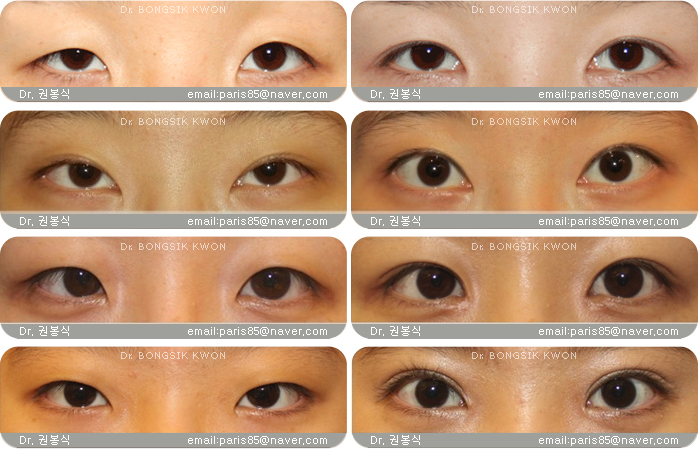
Examples)Combination of magic epicanthoplasty and double eyelid surgery in the case of severe epicanthus in male patient.

Examples) Sausage type of double eyelids were made after not taking epicanthoplasty . Magic epicanthoplasty and revisional double eyelid surgery refined the images of eye in manner of natural and distinctive looks.
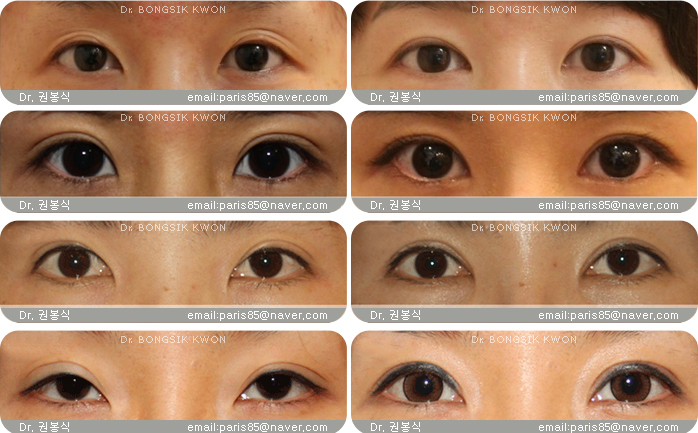
Examples) This case shows the negative effect of epicanthus on the outfold(parallel) double eyelid . There is no continuation of line up to the medial corner of the eye. Magic epicanthoplasty and medial correction of double eyelid refined the images of eye in manner of natural and distinctive appearance

Examples) Partial correction of double eyelid creases with magic epicanthoplasty in incomplete natural double eyelids with epicanthus. These types of double eyelid creases are usually formed at much lower position. When the magic epicanthoplasty is performed, it is frequently necessary to correct medial double eyelid creases at the same time in the epicanthal area to obtain clear double eyelids.

Examples)The effect of magic epicanthoplasty to the double eyelid crease. Only the magic epicanthoplasty is performed without correcting the line. Some people just prefer infold crease.

Examples) Buried suture method (non-incisional double eyelid surgery) with magic epicanthoplasty was performed to correct the creases. It shows slight outfold (parallel) lines after surgery.
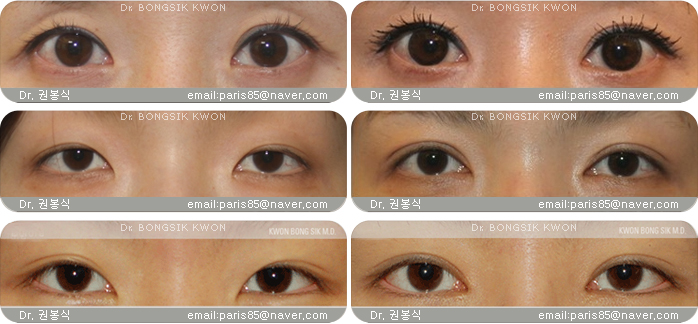
Examples) These are the cases which show vertical tension of epicanthus in the eyes with outfold double eyelid. Clearer creases were made by the combination of magic epicanthoplasty and medial correction of double eyelid.

05Types of the double eyelid – Infold, Inout-fold, Outfold
Inner-fold double eyelid

Infold double eyelid
Infold double eyelid
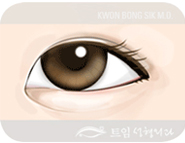
Examples) Performing only double eyelid surgery on these kinds of eyes renders them have infold type eyelids

Examples) Slight improving of infold crease ,slight amount of inner corner exposure by magic epicanthoplasty in severe infold type eyelids.

Examples) converting of infold crease to inout-fold by magic epicanthoplasty and partial correction of medial crease with non-incisional anchoring

Examples) Structural double eyelid surgery combined magic epicanthoplasty and double eyelid surgery for parallel type of double eyelid.
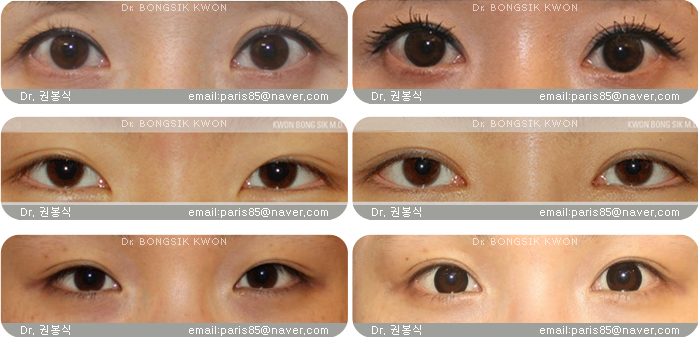
Inout-fold double eyelid
Inout-fold double eyelid (tapered type)
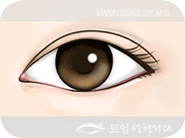
Examples) Combination of Magic epicanthoplasty and non-incisional double eyelid surgery to make an inout-fold crease.

Examples) Magic epicanthoplasty with partial correction of medial crease can convert an infold to an inout-fold crease.
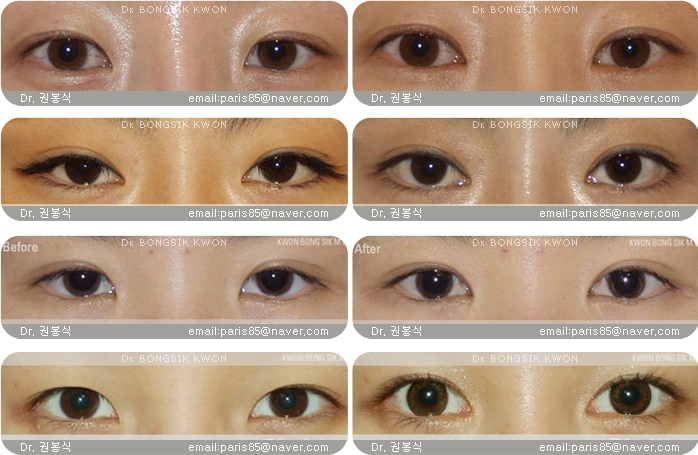
Outfold double eyelid
Outfold double eyelid (parallel type)
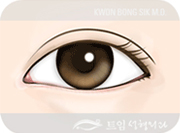
The distance between the eye and eyebrow is long.
The eyelid skin is thin
The function of the muscle to open the eyes is good.
verticallly longer tarsal plate
The relative protruding eyeball type
In Asians, outfold type can be by made double eyelid surgery combined with proper epicanthoplasty. But high outfold can look unnatural even after proper combined surgery in unfavorable conditions, because of the structural differences of Asian eyes. When only the double eyelid surgery is performed, swelling will be severe and may last for a long time(sausage phenomenon). This will lead to unnatural eyelid look. So the limitation of outfold height shoud be determined according to the given anatomical conditions for natural looking eye.
Example) Semilunar double eyelid of a Westerner. The crease is relatively wide and deep under orbital bone. The semilunar supratarsal crease of Westerner is somewhat different from parallel double eyelid of Asian. The orbital bone structures and soft tissues are different in shape. So, even though Asian have outfold double eyelids, crease location and contour are somewhat different from a Caucasian’s semilunar crease.

Examples) High and unnatural double eyelid line without the improvement of epicanthus

Examples) Combination of magic epicanthoplasty and revisional double eyelid surgery in case with sausage phenomenon and iatrogenic ptosis

Examples) An outfold crease in an Asian eye with epicanthus looks unnatural and incomplete. Magic epicanthoplasty was performed to correct them.
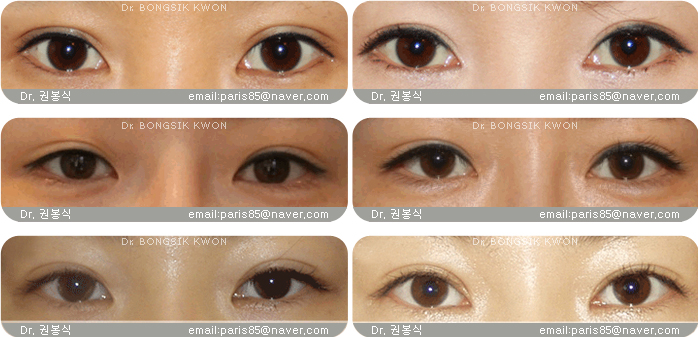
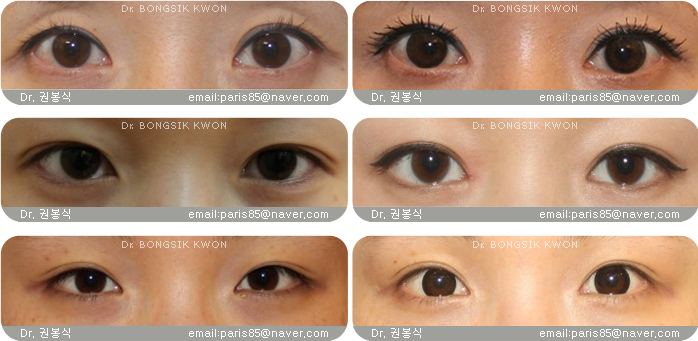
Examples)Double eyelid surgery, ptosis correction with epicanthoplasty. Notice minimal epicanthus before epicanthoplasty.

The devolutional Asian blepharoplasty resolved previous limitation and extended possible asthetic aim and enable to form parallel double eyelid which looks naural without surgical mark.
Examples)Structural double eyelid surgery combined with the magic epicanthoplasty and double eyelid surgery for parallel type of double eyelid.

Examples)Magic epicanthoplasty combined with a non- incisional double eyelid surgery

Examples)Combined magic epicanthoplasty and double eyelid surgery.


Examples)double eyelid surgery without epicanthoplasty in case of minimal epicanthus. Notice the degree of an outfold line that can be permitted to Asians in case of minimal epicanthal tension.

06How do you know which type and which height to take? An infold, inout-fold,outfold?
If the eyelid crease in the inner corner of the eyes is not clearly visible due to the epicanthus , it is an infold. The infold crease is usually very low. Although low Asian crease is generally infold, it looks natural. In cases of Asian descent who have a crease congenitally, the crease is usually low infold or inout crease. If the epicanthus is mild, the congenital crease is usually medium height inout crease. For natural image of surgical result, the relationship of the epicanthus and double eyelid should be taken into account.
If it is located on the epicanthus apart from medial canthus , it is an outfold. The height of outfold is usually more than medium. To form an high outfold like those of the Westerners, patient should undergo the epicanthoplasty and resolve epicanthus . For ease Asian decent, people don’t have depressed eyeball socket characteristics and high nose, so the high outfoldmay turn out unnatural in structural aspects. But an inout-fold or medium outfold can turn out to be relatively natural with structural eyelidplasty (combined epicanthoplasty and double eyelid plasty)and is usually recommended.
Previously many patients concerned about whether to take the epicanthoplasty or not. Now it is definite that the epicanthus determines the type of double eyelid crease and natural images after Asian blepharoplasty . So, devolution epicanthoplasty must be accompanied for higher parallel crease and a natural-looking, stable inout crease in Asians.The higher outfoldcrease patient prefer, the epicanthoplasty is more instrumental in Asian blepharoplasty.
It is not true that only large double eyelids make big and beautiful eyes. Because skin thickness, fat, muscle, surround bony structure of eye are different in each person, proper height is also different in each case. The most important key for natural looking beautiful eyes depends on the designed height of the double eyelid which is appropriate for each anatomical condition. An inadequate height can make eyes look unnatural and disturb functioning of the eyes (opening and closing the eyes) and will swell for a long time, and even look as if people have drowsy looking eyes.Patient should understand that there is medical limitation in crease height and crease type to preserve natural image of the eyelid after Asian blepharoplasty.
Examples)This is a case of an infold crease without improving the epicanthus. Magic epicanthoplasty with partial correction of medial crease is done to create an inout-fold crease

Examples)This is a picture of an infold without improving the epicanthus. Magic epicanthoplasty and revisional double eyelid surgery is done to form an inout-fold crease.

Examples)An infold without improving the epicanthus. Magic epicanthoplasty with revisional double eyelid surgery is performed to create symmetric outfold crease.

07The reason why the medial double eyelid is likely to get attenuated or fade inceptively

Examples)This is a case of an infold crease without resolving the epicanthus. Magic epicanthoplasty with partial correction of medial crease is done to create an inout-fold crease
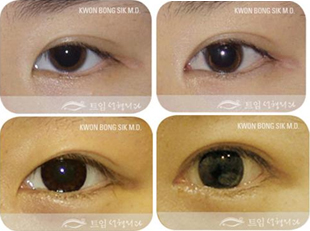
08The epicanthus as a cause of fading double eyelids in Asian eyelid.
Although the fading of double eyelid is undesirable, it may occur after some period of time. The most important thing is to analyze the causes and correct them by applying suitable methods.
There are three main causes for fading. First, it is caused by weak fixation. Second, it is caused by blepharoptosis(weak eye-opening power). Third, the epicanthus plays an important role for the fading of the crease. Unless a double eyelid surgery meets certain requirements, the double eyelid crease will not be able to last for long time. If a person with severe epicanthus undergoes a double eyelid surgery only, the crease of the eye would rather get loose or fade out. When severe epicanthus makes the double eyelids look unnaturally thick(sausage phenomenon) after double eyelid surgery only, it is not easy to correct after all. So the structural Asian eyelidplasty (combined epicanthoplasty and double eyelidplasty) based on devolutional concept should be performed in primary surgery.
There are many differences in devolutional eyelidplasty from conventional eyelidplasty without devolutional concept. In devolutional eyelidplasty, destructive procedures on the surgical crease for stronger adhesion becomes less necessary. The epicanthus exists as a remnant fibromuscular volume on the upper medial canthal region with vertical(actually diagonal, relative meaning in relation to horizontal supratarsal crease) skin shortage and tension which causes difficulty in horizontal skin folding. It acts as a major hindrance of a double eyelid formation in Asian blepharoplasty. The fibrous tissues and malpositioned orbicularis muscle prevents the even transmission of levator muscle power toward the medial skin because the aponeurotic fibers have been detached and do not extend to the epicanthal skin area any more.
The preexisting vertical skin tension acts as tensional stress on newly formed surgical crease. The epicanthal skin tension is considered as a major factor which inhibits the sustainability of surgical crease in Asian double eyelidplasty. Also, the malpositioned orbicularis muscle can be reactivated as a vertically acting inhibitor which causes active tensional stress on mid-lateral surgical crease, especially when we have performed the outfold type double eyelidplasty without epicanthoplasty.

The tensional stress on crease by vertical skin tension is the main cause of crease loss after double eyelidplasty in Asians. Contraction of malpositioned orbicularis oculi muscle in a vertical direction is also a potential lcause of tensional stress on surgical crease. Because we have resolved the possible causes of crease loss with devolutional epicanthoplasty, aggressive adhesion which performed in conventional method is less necessary. In more cases, we can apply non-incisional method for crease formation except excessively thick skin condition with true epiblepharon.
When we should remove excessive and malpositionedsoft tissues in cases of droopy eyelids with epiblepharon, conservative resection for resolving the displaced soft tissues of the anterior lamella and partial removal of preaponeurotic fat in the posterior lamellais enough without unnecessary tissue injury. The overactive resection and resultant unnecessary tissue injury only cause prolonged swelling and depression scar.
We think that we need to review conventional procedures of Asian blepharoplasty and theoretical background for adjusting to devolutional Asian blepharoplasty appropriately. If we agree with the eyelid evolution and understand about the epicanthus in relation to double eyelid better, Asian double eyelidplasty would need to be refined more in combination with epicanthoplasty under the devolutional concept.
The epicanthus and epiblepharon is same manifestation except their location. Both are composed of preseptal orbicularis muscle and degenerative fibrous tissues which replaced the room of atrophied orbicularis oculi muscles. There are more incidences of mild blepharoptosis in Asian eyelids.
We think mild blepharoptosis in Asian eyelid is related with the specifics of eyelid evolution. After the evolutional process, the loading conditions of levator muscle had worsened. The fibrous tissues within the epicanthus and the epiblepharon, vertical skin tension on upper eyelid, hypertrophied orbicularis oculi muscle and hypertrophied preaponeurotic fat pad increase loading onto the levator and Muller muscle, and act as causal factors of blepharoptosis. Patients can often experience the improvement of mild blepharoptosis after devolutional epicanthoplasty. When we evaluate blepharoptosis, we should consider the epicanthus-related factors. When we perform blepharoptosis surgery with devolutional epicanthoplasty simultaneously, correction of blepharoptosis becomescomplete and is expected to get better results.
Examples) Getting loose or fading of crease after inappropriate solitary double eyelid surgeries
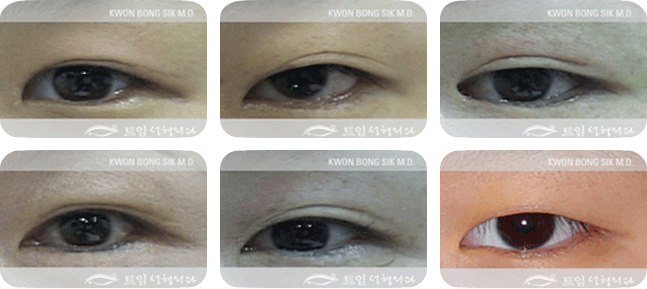
Examples) Cases where combined double eyelid surgery and epicanthoplasty are necessary

Examples) The creases after solitary non-incisionaldouble eyelidsurgery results in infold type. The right crease faded out. After magic epicanthoplasty and double eyelid surgery (buried suture method), it shows symmetrical inout- fold double eyelid.

Examples)Combination of magic epicanthoplasty and revisional double eyelid surgery. If an medium height of inout-fold crease is tried to be created without improving the epicanthus, the medial double eyelid crease will fade away easily. The creases (pre revisional photo) seem unattractive. A crease created by the combined epicanthoplasty and double eyelid surgery provides a clear and natural appearance. When epicanthi are severe, the structural double eyelid surgery should be performed to create stable and attractive inout or outfold crease.
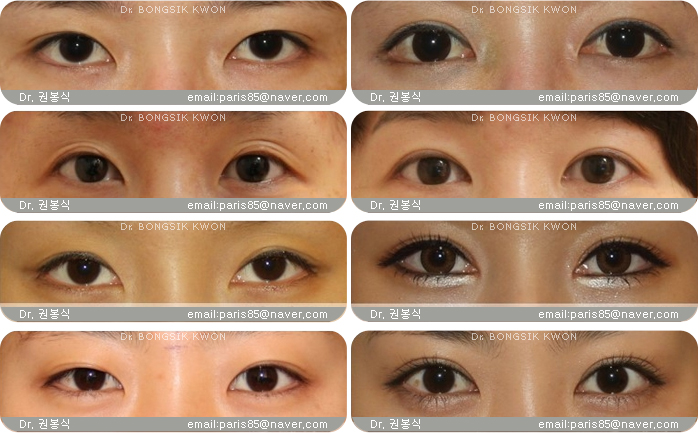
Examples) These cases show the negative effect of epicanthus in the cases in which solitary outfold double eyelid surgery is performed. There is sausage-like fullness and no continuation of crease up to the medial corner of the eye(above). Magic epicanthoplasty and revisional double eyelid surgery refined the eyelid in manner of natural and distinctive appearance.


Examples) This case shows the negative effect epicanthus in the eyelid after solitary outfold(parallel) double eyelid surgery. There is no continuation of crease to the medial corner of the eye(above). Magic epicanthoplasty refined the images of eye in manner of natural appearance. If an outfold(parallel) crease is created without improving the epicanthus, the double eyelid crease will look awkward and incomplete. The creasees (pre revisional photo) seem very unnatural. A crease created by the combined epicanthoplasty and double eyelid surgery provides a clear and natural appearance on proper anatomical conditions. When epicanthi are severe, the structural double eyelid surgery including proper surgical technique for resolving epicanthus should be performed to create beautiful and admirable eyes.

Examples) These cases show the negative effect of epicanthus. There is asymmetric natutal double eyelid crease on the medial corner of the eye. Magic epicanthoplasty and double eyelid surgery refined the images of eye in manner of symmetric outfold(parallel crease) appearance.

09Pre-surgery consultation
At consultation, a patient should thoroughly explain what he/she wants to gain from the surgery. And the doctor must fully understand the expectations by the patient and explain the possible and impossible things that could be done to give the best results. If your eyebrows look like they are hanging down too much, the doctor may consider lifting it up(brow lift surgery) along with your eyelid surgery. Surgical methods are determined among an incision, partial incision method, or the buried suture method.
10Scars after double eyelid surgery
In devolutional Asian eyelidplasty, destructive procedures on surgical crease for stronger adhesion is less necessary. The tensional stress on crease by vertical skin tension is main cause of crease loss after double eyelidplasty in Asians. Contraction of malpositioned orbicularis oculi muscle in vertical direction is also a potential cause of tensional stress on surgical crease. Because we have resolved the possible causes of crease loss with devolutional epicanthoplasty, aggressive adhesion which performed in conventional method is less necessary. In more cases, we can apply non-incisional method for crease formation except excessively thick skin condition with true epiblepharon.
When we should remove excessive and malpositioned soft tissues in cases of droopy eyelids with epiblepharon, conservative resection for resolving the displaced soft tissues of the anterior lamella and partial removal of preaponeurotic fat in the posterior lamella is enough without unnecessary tissue injury. The overactive resection and resultant unnecessary tissue injury only cause prolonged swelling and depression scar. Therefore there would be less chance of hypertrophic or depression scar in structural Asian blepharoplasty based on devoutional concept.
Examples)Magic epicanthoplasty and a revisional double eyelid surgery. The scar has been removed.

11Method for a double eyelid surgery : non-incision, natural adhesive
For the buried suture method, we must consider the amount of ptosis, size of eyes, thickness of tissues of the eyelids, the degree of the hanging down of the eyelids, your skin, and your muscles. The buried suture method needs to make small halls with the needle in several units for binding skin and levator muscle through these holes. If you feel that you cannot see much of a difference after the surgery, or if your new image is hard to accept, it can be returned to your original natural state by the removal of the suturing thread. This surgery is operated by very a very small incision (usually 1-2mm.). Usually after the surgery, a scar cannot be seen, even without make-up on.
Examples)Magic epicanthoplasty combined with a non-incisional double eyelid surgery.
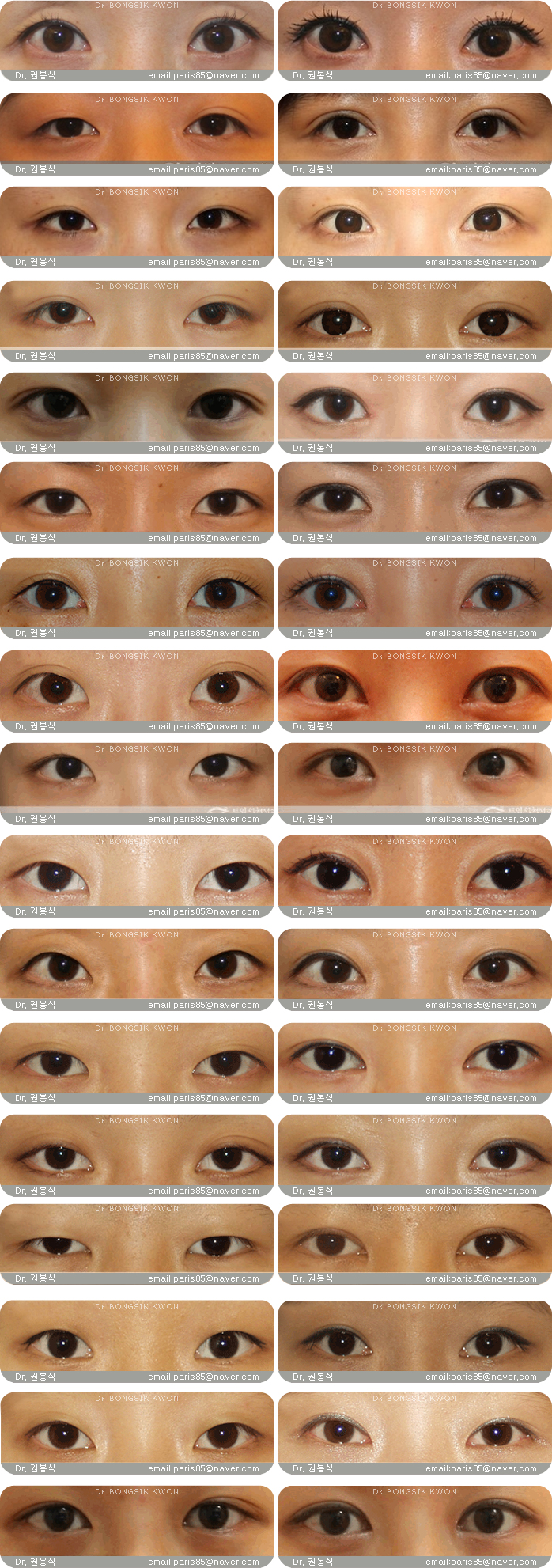
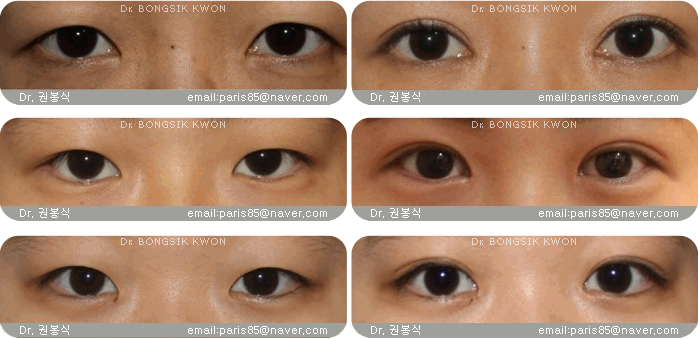
Examples)Magic epicanthoplasty combined with a non-incisional double eyelid surgery. The actual double eyelid crease is designed at lower level intentionally according to patient’s demand.
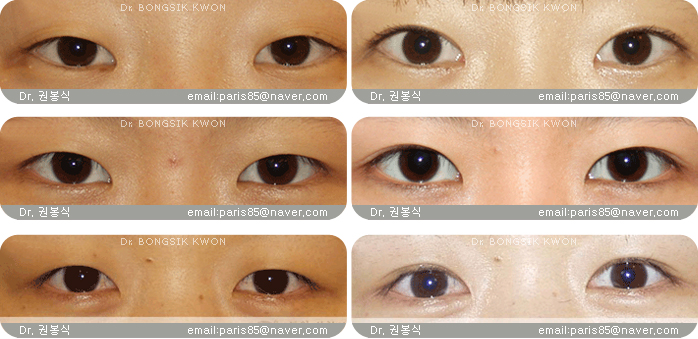
Examples) Only a non-incisional double eyelid surgery was performed.
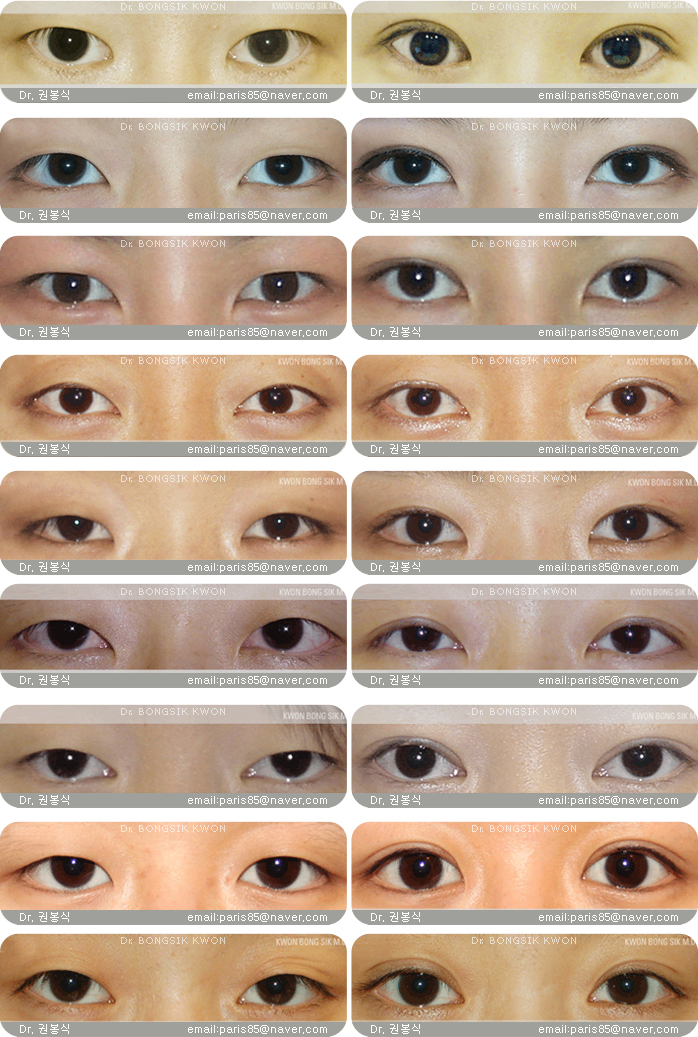
Examples)Magic epicanthoplasty combined with a non-incisional double eyelid surgery in a male patient.

Techniques of the buried suture method
Who are suitable for the buried suture method?
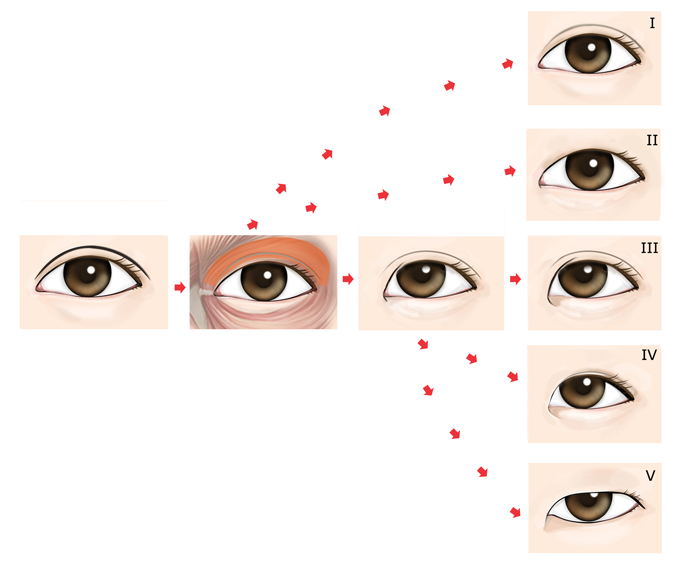

Favorable conditions for non-incisional method
1. Eyes with not much fat and with thin eyelids.
2. People with a double eyelid on only one side of the eye.
3. Eyelids that are not symmetric and are imbalanced.
4. Men who want to get small crease .
5. People who have eyes that are easy to make double eyelids with tapes or glue.
6. Eyes that sometimes form double eyelids but sometimes not.
7. Eyes that have an indistinct double eyelid crease.
Advantages of the buried suture method
Concerns about the double eyelid fading away
Examples)Magic epicanthoplasty combined with non-incisional double eyelid surgery in eyes that have faded lines.
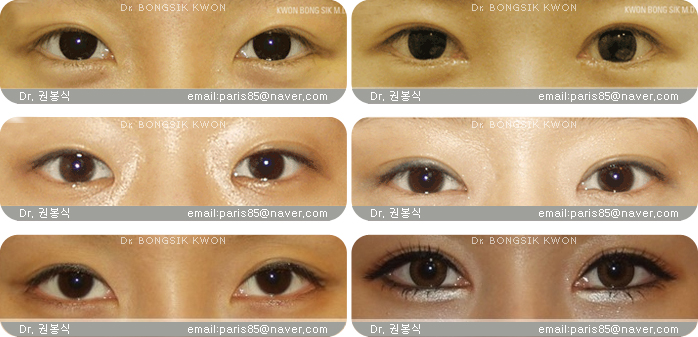
Buried suture method for eyelid skin that hangs down.
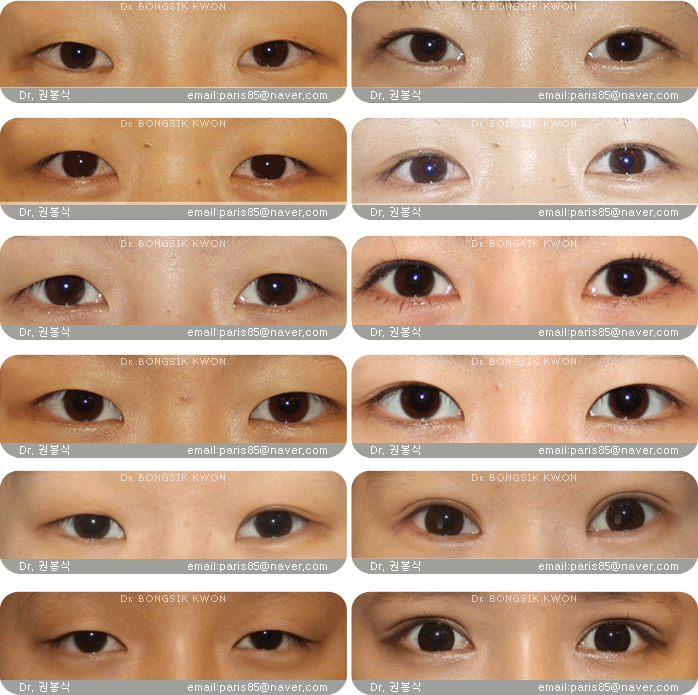
Is there a special clinic for the buried suture method?
12Method for a double eyelid surgery : Partial incision
What is a partial incision?

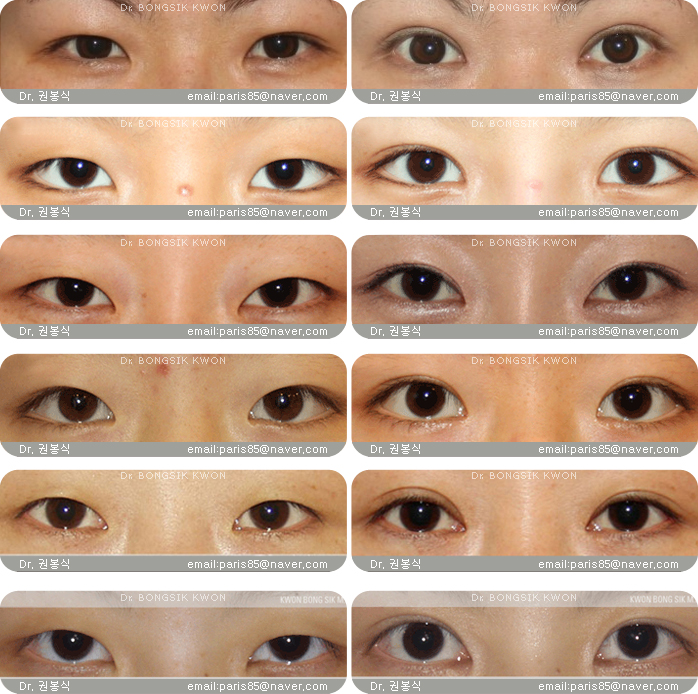
Advantages and disadvantages of the partial incision method
Patient will experience a rapid recovery. Also the fat of the eye will be minimized.
1. It is unnecessary to worry about a scar after surgery with minimized incision.
2. Fat is removed.
3. Recovery time is short.
Disadvantages
1. It cannot be applied to eyes that show true epiblepharon
2. The swelling eases faster than that of the full incision or excision method, but more than that of the buried suture method.
13Method for a double eyelid surgery : Full incision
Incision/Excision

The types of eyes that need the incision method
Structural eyelidplastytin Asian eyelid : Combined Epicanthoplasty and Double Eyelidplasty as One Surgery : new paradigm in Asian double eyelid surgery
Teuim plastic surgery performs both surgeries at the same time and creates the best eyes for patients. We highly assure that this complex operation would be the basis for the plastic surgery of Asian eyes in the future worldwide. In devolutional eyelidplasty, destructive procedures on surgical crease for stronger adhesion is less necessary. The tensional stress on crease by vertical skin tension is main cause of crease loss after double eyelidplasty in Asians. Contraction of malpositioned orbicularis oculi muscle in vertical direction is also a potential cause of tensional stress on surgical crease. Because we have resolved the possible causes of crease loss with devolutional epicanthoplasty, aggressive adhesion which performed in conventional method is less necessary.
When we should remove excessive and malpositioned soft tissues in cases of droopy eyelids with epiblepharon, conservative resection for resolving the displaced soft tissues of the anterior lamella and partial removal of preaponeurotic fat in the posterior lamella is enough without unnecessary tissue injury. The overactive resection and resultant unnecessary tissue injury only cause prolonged swelling and depression scar.

Concerns about remaining scars from an incision.
If you are scared to take the incision.
Examples)preoperative, postoperative 2months, postoperative 1year open eye, postoperative 1 year closed eye

Eye enlargement surgery( aesthetic ptosis correction, eye-opening refinement surgery)
This is a surgery that enlarges your eyes vertically. Using the technique of ptosis surgery, we strengthen the muscles that open the eyes and make eyes look clearer by exposing more of the iris. A weak ptosis is often seen in Asians. These eyes cover the iris and give a tired feeling even after a double eyelid surgery. In cases where the iris is covered with the eyelid, this surgery should be taken in addition to double eyelid surgery.
Examples)Double eyelid surgerywith an eye enlargement surgery
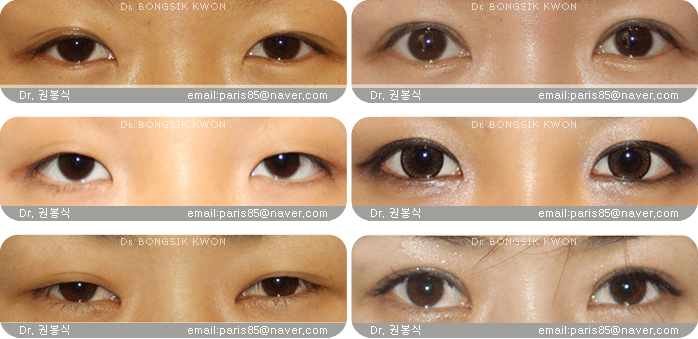
Examples)Revisional double eyelid surgery with an eye enlargement surgery.

14Teuim complex enlargement surgery.
Examples)Magic epicanthoplasty combined with an excisional double eyelid surgery and lateral canthoplasty

Examples)Magic epicanthoplasty combined with an excisional double eyelid surgery
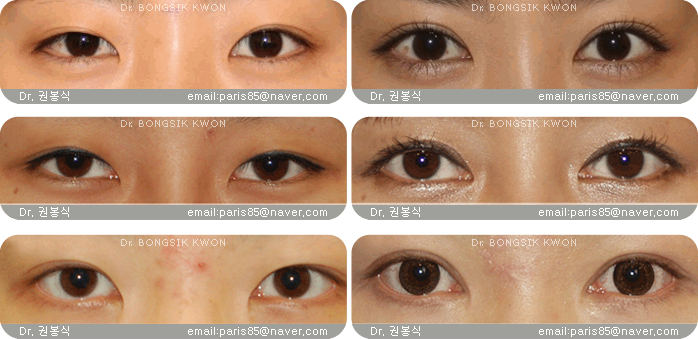
15Suggestions for various eyelid
Eyes that look swollen and puffy.
Examples)Puffy eyes make the eyes look swollen
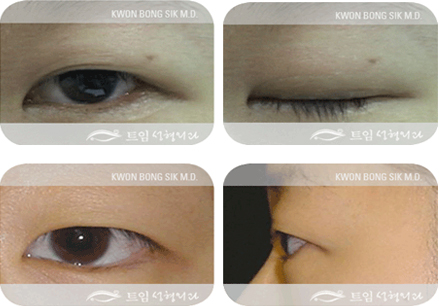
Examples)An incisional method for the double eyelid surgery

Eyes that originally have thin eyelid skin
Examples)The result of the buried suture method(non-incisional double eyelid surgery) from a patient with very thin eyelid skin

Examples)Magic epicanthoplasty combined with a non- incisional double eyelid surgery

Eyes which show multiple wrinkles
Examples) A case when many eyelid wrinkle lines are overlapped on eyes

Examples)The multiple eyelid lines are converted to a single clear crease after the buried suture method

Examples) non-incisional double eyelid surgery and fat graft over sunken eyelid are performed

Examples) Magic epicanthoplasty, excisional double eyelid surgery and fat graft over sunken eyelid are performed.

Eyes with damaged skin by using adhesives like Eyecharm(tape forming double eyelid) or glue

Examples) Magic epicanthoplasty combined with non-incisional double eyelid surgery

Eyes that form double eyelids only from time to time
Examples) Eyes that form a double eyelid from time to time.

Examples) Eyes changed into a clear double eyelid by magic epicanthoplasty and the non-incisional double eyelid surgery
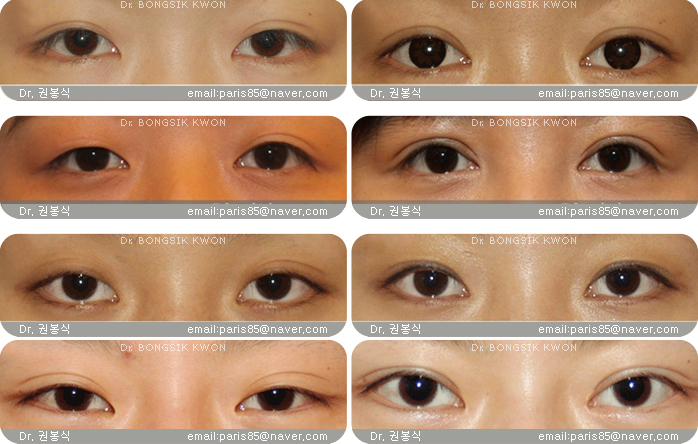
Eyes that give a sleepy or glaring image because of the coverage of the pupil and iris.
Examples) The amount of exposure of the pupil is normalized by the magic epicanthoplasty and a double eyelid surgery with ptosis correction. They had true ptosis preoperatively.
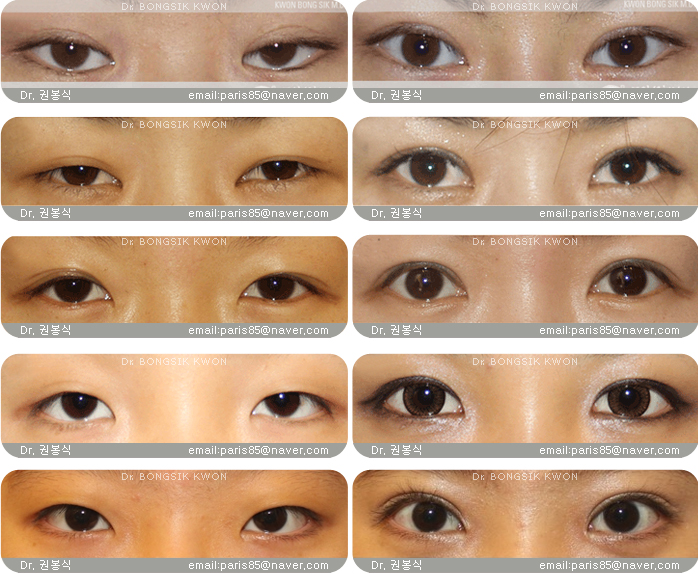
Examples) The amount of exposure of the pupil is increased by the magic epicanthoplasty and a double eyelid surgery without ptosis correction. They have mild blepharoptosis.
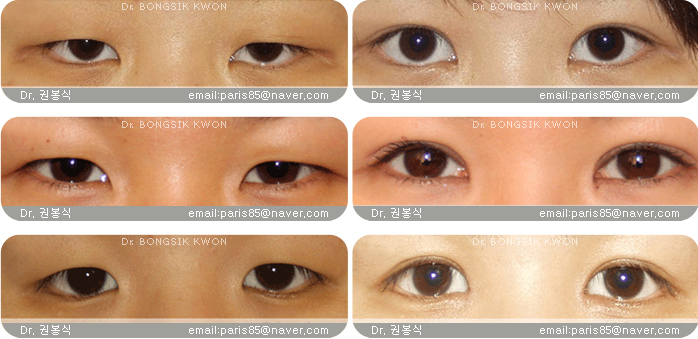
Eyes that have a wide space between the two corners of the eyes
Examples) Magic epicanthoplasty, double eyelid surgery and augmentation rhinoplasty are all performed together in male patient.

Examples )Magic epicanthoplasty, double eyelid surgery and augmentation rhinoplasty are all performed together to bring the maximal result in female patient.

Examples) Magic epicanthoplasty combined with double eyelid surgery including ptosis correction.

Double eyelids that are not symmetric each other.
Examples) Magic epicanthoplasty and double eyelid surgery
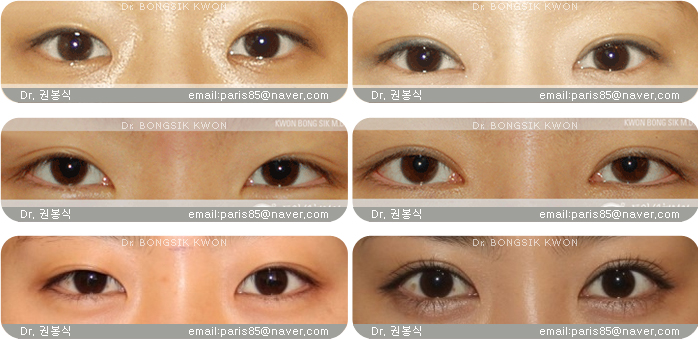
People who have a double eyelid on only one side of the eye
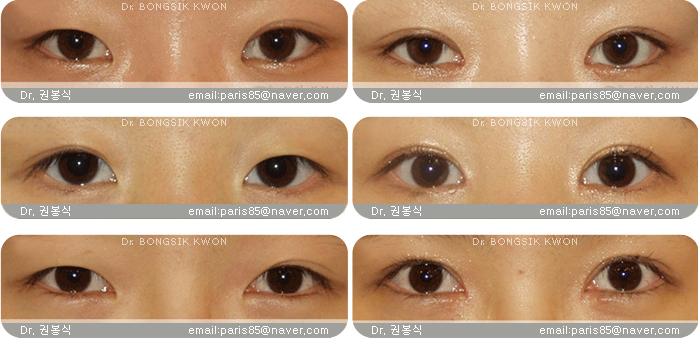
Eyes that are pointed upwards or downwards

Examples) Magic epicanthoplasty combined with double eyelid surgery

Examples) Sub-brow lift surgery.
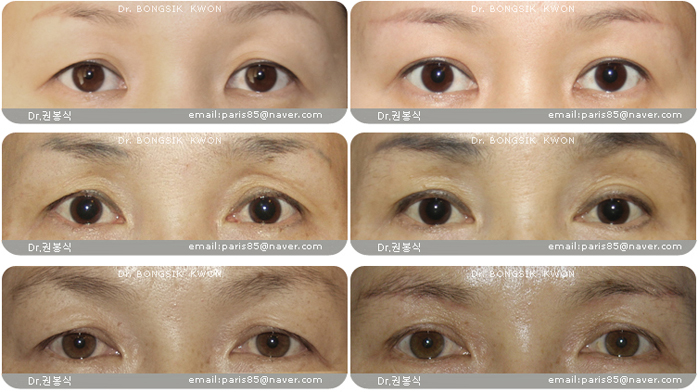
Eyes that look sunken due to insufficient fat .
Examples) Upper eyelid sunken can be corrected by the autologous microfat graft
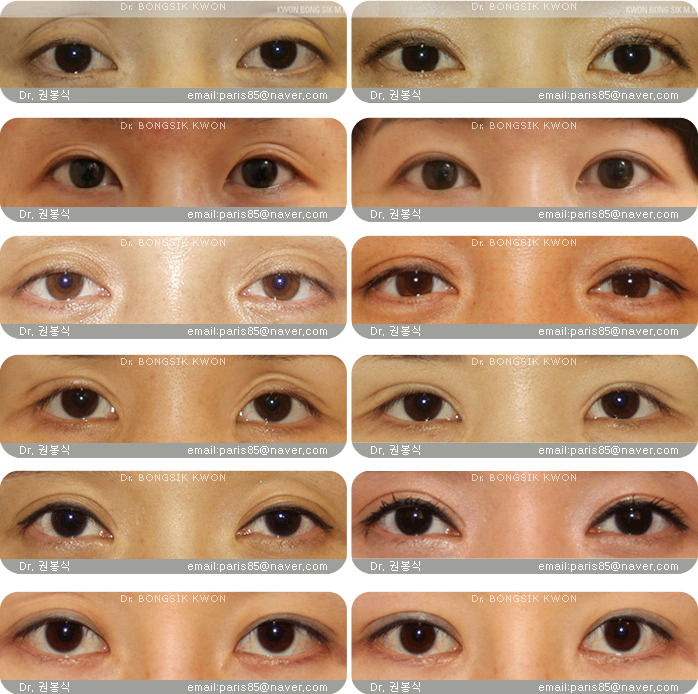
Eyes that are easily prickled by inward eyelashes (by epicanthus or Epiblepharon)
Examples) Upper eyelid sunken can be corrected by the autologous microfat graft

Eyes that makes a person look sleepy
Examples) Magic epicanthoplasty and a double eyelid surgery with ptosis correction.
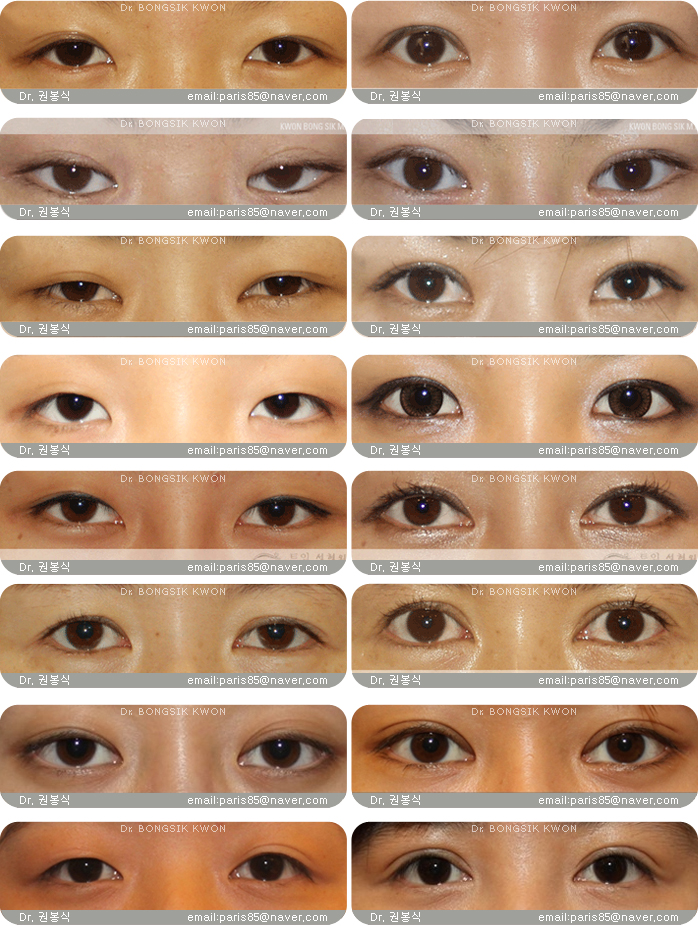
Eyes with protruding eyeballs
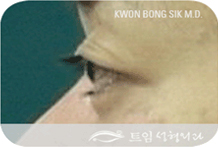
Eyeball protrusion such as these are caused by the exophthalmos. The excision of skin method or the removal of fat is usually unnecessary. Partial incision or the buried suture method can be easily applied to make natural looking double eyelids with/without epicanthoplasty.










